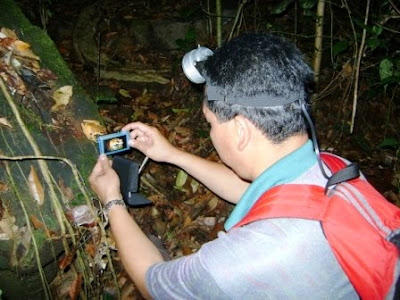Pycnonotus melanoleucos is confined to the Sundaic lowlands, where is it known from peninsular Thailand, Sabah, Sarawak and Peninsular Malaysia, Singapore (formerly), Kalimantan and Sumatra (including Mentawai Island), Indonesia and Brunei. In is generally scarce, although it is sporadically fairly common in parts of Peninsular Malaysia and Borneo. It may undertake nomadic movements.
This species occurs in broadleaved evergreen forest (including selectively logged forest), mixed-dipterocarp forest, secondary growth and forest edge, from lowlands up to at least 1,830 m. It is also recorded from luxuriant gardens and cultivation, peatswamp forest and overgrown plantations. Its nomadic tendencies suggest a degree of specialisation in foraging niche, although further research is needed to determine its habitat requirements.

Threats Rates of forest loss in the Sundaic lowlands have been extremely rapid, owing partly to the escalation of illegal logging and land conversion, with deliberate targeting of all remaining stands of valuable timber including those inside protected areas. Forest fires have also had a damaging effect (particularly in 1997-1998). The magnitude of these threats may be allayed by this species's tolerance of hill forest, which is under less pressure from logging and agricultural conversion. However, as a nomadic species, it may be more susceptible to the effects of habitat fragmentation.
Conservation measures proposed Conduct ecological studies to improve understanding of its precise habitat requirements, particularly the causes of nomadic movements, as well as levels of persistence in secondary and fragmented habitats. Conduct repeated surveys within the range to determine current distribution and abundance, as well as assess population trends and rates of habitat loss. Effectively protect significant areas of suitable forest at key sites, in both strictly protected areas and community led multiple use areas.

This scarce and pooprly known species is currently considered Near Threatened, as it is suspected to be declining moderately rapidly throughout its range as a result of continuing habitat loss.
2009 IUCN Red List Category (as evaluated by BirdLife International - the official Red List Authority for birds for IUCN): Near Threatened
BirdLife International (2009) Species factsheet: Pycnonotus melanoleucos. Downloaded from http://www.birdlife.org/ on 13/10/2009
**As i read through the information that i found, this bird is quite interesting. There are still a lot more to learn and understand about it (before it is too late). Actually this was my first experienced seeing this bird this close. It is always an exciting and amazing experience.
 In this photo you see it quite large but actually this is a very tiny plants. I think one tree (lump of leaves) is about 1cm. It is very small. That's why i thought it was a moss.
In this photo you see it quite large but actually this is a very tiny plants. I think one tree (lump of leaves) is about 1cm. It is very small. That's why i thought it was a moss. 







